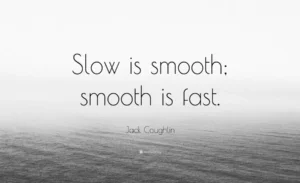Blog
Slow is Smooth Smooth is Fast

The phrase “slow is smooth, smooth is fast” encapsulates a concept that resonates deeply across various disciplines, from military training and martial arts to project management and personal development. At its core, this principle emphasizes the importance of deliberate, measured actions to achieve efficiency and precision. By focusing on smoothness, or consistency, the speed necessary for success becomes a natural byproduct rather than a forced outcome. While the phrase has its origins in tactical and survival training, its broader applications offer profound insights into how individuals and organizations can approach challenges and goals.
The Origin and Philosophy Behind the Phrase
The phrase is often associated with the military, particularly in training environments such as those found in the Navy SEALs and other elite special operations forces. In these high-stakes contexts, rushing can lead to mistakes that cost lives. The principle teaches trainees to prioritize accuracy, coordination, and presence of mind over speed. When actions are performed deliberately and with precision, they flow smoothly, and speed becomes an organic result.
This philosophy can be boiled down to one essential idea: efficiency stems from mastery, and mastery is achieved through intentional practice. Rushing through a task without understanding or controlling the process often results in errors and inefficiencies that demand more time to correct. The idea of slowing down to achieve better results has parallels in Eastern philosophies like Zen Buddhism, which emphasizes mindfulness and deliberate action in every task. The principle encourages individuals to live fully in the present moment, aligning their thoughts, emotions, and actions to create harmony.
Applying “Slow is Smooth, Smooth is Fast” in Daily Life
1. In Personal Growth and Learning
When embarking on personal growth journeys or acquiring new skills, many people fall into the trap of wanting to achieve results as quickly as possible. This impatience often leads to burnout, frustration, or surface-level understanding. The “slow is smooth, smooth is fast” mindset encourages learners to focus on mastering foundational skills before progressing.
For instance, when learning a new language, rushing to memorize vocabulary without understanding grammar rules or pronunciation can lead to gaps in communication skills. A more methodical approach—starting with basic phrases, practicing pronunciation, and gradually expanding vocabulary—ensures a smoother learning experience. The same principle applies to physical skills like playing an instrument or engaging in athletic training, where deliberate practice builds muscle memory and prevents injury.
2. In Relationships and Communication
In interpersonal relationships, haste often leads to misunderstandings and conflicts. Responding impulsively in conversations or trying to rush through important discussions can result in a lack of clarity and hurt feelings. The principle of taking things slow allows for better listening, understanding, and emotional connection.
For example, during a disagreement, pausing to truly listen and process the other person’s perspective fosters smoother communication. This deliberate approach minimizes the likelihood of escalating the conflict, allowing for a faster resolution in the long run. Whether it’s nurturing a romantic relationship, building friendships, or maintaining professional connections, patience and thoughtfulness pave the way for stronger, smoother interactions.
The Role of Discipline and Consistency
Discipline is a critical component of the “slow is smooth, smooth is fast” philosophy. Consistency, born from discipline, enables progress to occur in a measured and sustainable way. In both personal and professional contexts, setting a steady pace and adhering to it prevents the pitfalls of rushing or cutting corners.
Consider the workplace, where employees often face tight deadlines and high expectations. While the pressure to produce results quickly can be overwhelming, rushing tasks without proper planning or attention to detail often leads to errors and rework. Taking the time to plan, organize, and execute tasks systematically ensures smoother workflows and better outcomes.
Discipline also plays a role in building habits. Whether it’s committing to a fitness routine, improving mental health through mindfulness, or enhancing skills in a specific area, slow and steady progress ensures sustainability. Those who adopt a rushed approach might achieve temporary results but often struggle to maintain them.
“Slow is Smooth” in Leadership and Decision-Making
Leadership demands a careful balance between decisiveness and deliberation. While quick decisions are sometimes necessary, many scenarios require leaders to pause, gather information, and analyze the situation before acting. The principle of “slow is smooth, smooth is fast” reminds leaders to approach challenges with a clear mind and strategic thinking.
For example, in times of crisis, a leader who acts impulsively risks compounding the problem. Conversely, a leader who slows down to assess the situation, consults their team, and considers all options can respond more effectively. Smooth leadership involves maintaining clarity under pressure, which often leads to faster recovery and resolution.
The same principle applies to long-term planning. Leaders who invest time in building strong foundations—whether through team development, resource allocation, or organizational culture—find that progress accelerates as their initiatives gain momentum. The deliberate pace at the outset creates smoother operations in the future, ultimately leading to greater efficiency and impact.

Practical Techniques for Embracing the Principle
Mindfulness and Focus
Developing mindfulness is one of the most effective ways to implement the “slow is smooth” mindset. Techniques such as meditation, deep breathing, and journaling help individuals stay present and focused. When distractions are minimized, actions become more deliberate and efficient.
Setting Clear Priorities
Incorporating this principle requires prioritizing tasks to ensure that efforts are directed toward meaningful goals. A clear focus allows individuals to channel their energy smoothly, avoiding the inefficiency of multitasking or pursuing conflicting objectives.
Practicing Patience
Patience is both a skill and a mindset. It involves accepting that some things take time and resisting the urge to force outcomes. Practicing patience allows individuals to build resilience and maintain a steady pace, ensuring smoother progress.
Balancing Speed and Quality
While the principle emphasizes slowing down, it does not advocate for unnecessary delays. The goal is to find a balance where actions are performed with precision and purpose, leading to quality results. This balance ensures that speed emerges naturally as a result of smooth execution.
In professions like surgery, this balance is critical. A rushed procedure can result in mistakes with serious consequences, while overly slow actions can increase risks to the patient. The surgeon must perform each step with calm precision, allowing the process to flow smoothly and efficiently. Similarly, athletes often achieve peak performance by focusing on technique rather than sheer speed, enabling them to perform faster over time.
Embracing the Philosophy in Challenging Times
Life’s challenges often test our ability to remain calm and deliberate. Stress and uncertainty can push individuals toward impulsive decisions, but the “slow is smooth” principle offers a valuable reminder to pause and recalibrate. During such moments, embracing deliberate actions and focusing on small, manageable steps can create a sense of control and clarity.
For instance, in the face of financial difficulties, individuals who take the time to evaluate their situation, create a budget, and seek professional advice are more likely to recover smoothly. Conversely, those who panic and make hasty decisions may exacerbate their challenges.
Conclusion
The principle of “slow is smooth, smooth is fast” offers timeless wisdom for navigating life with intentionality and grace. It underscores the importance of focusing on precision, consistency, and discipline to achieve efficiency and success. By slowing down, we allow ourselves the space to master foundational skills, make informed decisions, and cultivate meaningful relationships. This approach ensures not only smoother outcomes but also a sustainable path toward growth and accomplishment. Whether in personal development, leadership, or daily tasks, embracing this philosophy empowers us to move through life with purpose and poise, proving that true speed is the product of careful, deliberate action.
FAQs:
1. What does “slow is smooth, smooth is fast” mean?
The phrase means that by taking deliberate, thoughtful, and precise actions, you can achieve efficiency and speed as a natural outcome. Rushing often leads to mistakes and inefficiencies, while a measured approach ensures smoother progress and ultimately faster results.
2. Where did the phrase originate?
The phrase is commonly associated with military training, particularly in elite forces like the Navy SEALs. It teaches trainees to prioritize precision and coordination over speed, as mistakes in high-stakes situations can have serious consequences.
3. How can I apply this principle in my daily life?
You can apply this principle by focusing on deliberate actions, practicing patience, and emphasizing quality over speed. For example, in learning new skills, building relationships, or managing tasks, prioritize understanding and consistency rather than rushing to complete things quickly.
4. Does this principle advocate for slowness in all situations?
No, the principle doesn’t advocate for unnecessary delays. It emphasizes the balance between deliberate action and efficiency. The goal is to perform tasks smoothly, which naturally leads to speed over time.
5. How does this principle relate to productivity?
In productivity, this principle helps reduce errors, rework, and burnout by encouraging thoughtful planning and execution. It promotes sustainable progress and ensures that effort is directed toward meaningful goals without wasted energy.
-

 Blog10 months ago
Blog10 months agoDiscover The World Of Movies With Mkvcinemas.com
-

 Biography10 months ago
Biography10 months agoMadeline Argy: Age, Height, and Family Background Revealed
-

 Tech10 months ago
Tech10 months agoSimpCityForum: One of the Most Interesting Online Communities
-

 Biography10 months ago
Biography10 months agoCelebrityMeet Christina Erika Carandini Lee?: All You Need To Know
-

 Biography10 months ago
Biography10 months agoHow Old Is SZA Daughter? Discover SZA Daughter’s Age, Name, and More
-

 Biography10 months ago
Biography10 months agoMary Marquardt: The Woman Behind Harrison Ford’s Rise
-

 Crypto Currency10 months ago
Crypto Currency10 months ago5starsstocks .com: How It’s Useful and Helpful
-

 Blog10 months ago
Blog10 months agoWhat is FilthyGrid? Exploring the World of FilthyGrid
-

 Health & Fitness10 months ago
Health & Fitness10 months agoWhat Has Kiolopobgofit in It? Exploring the Enigmatic Concept
-

 Biography10 months ago
Biography10 months agoChevy Chase Net Worth, Bio, Age, Height, Wife & Family

